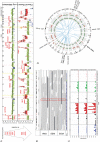Minimally invasive genomic and transcriptomic profiling of visceral cancers by next-generation sequencing of circulating exosomes
- PMID: 26681674
- PMCID: PMC4803451
- DOI: 10.1093/annonc/mdv604
Minimally invasive genomic and transcriptomic profiling of visceral cancers by next-generation sequencing of circulating exosomes
Abstract
Background: The ability to perform comprehensive profiling of cancers at high resolution is essential for precision medicine. Liquid biopsies using shed exosomes provide high-quality nucleic acids to obtain molecular characterization, which may be especially useful for visceral cancers that are not amenable to routine biopsies.
Patients and methods: We isolated shed exosomes in biofluids from three patients with pancreaticobiliary cancers (two pancreatic, one ampullary). We performed comprehensive profiling of exoDNA and exoRNA by whole genome, exome and transcriptome sequencing using the Illumina HiSeq 2500 sequencer. We assessed the feasibility of calling copy number events, detecting mutational signatures and identifying potentially actionable mutations in exoDNA sequencing data, as well as expressed point mutations and gene fusions in exoRNA sequencing data.
Results: Whole-exome sequencing resulted in 95%-99% of the target regions covered at a mean depth of 133-490×. Genome-wide copy number profiles, and high estimates of tumor fractions (ranging from 56% to 82%), suggest robust representation of the tumor DNA within the shed exosomal compartment. Multiple actionable mutations, including alterations in NOTCH1 and BRCA2, were found in patient exoDNA samples. Further, RNA sequencing of shed exosomes identified the presence of expressed fusion genes, representing an avenue for elucidation of tumor neoantigens.
Conclusions: We have demonstrated high-resolution profiling of the genomic and transcriptomic landscapes of visceral cancers. A wide range of cancer-derived biomarkers could be detected within the nucleic acid cargo of shed exosomes, including copy number profiles, point mutations, insertions, deletions, gene fusions and mutational signatures. Liquid biopsies using shed exosomes has the potential to be used as a clinical tool for cancer diagnosis, therapeutic stratification and treatment monitoring, precluding the need for direct tumor sampling.
Keywords: exosomes; liquid biopsy; next-generation sequencing; pancreatic cancer.
© The Author 2015. Published by Oxford University Press on behalf of the European Society for Medical Oncology.
Figures



Comment in
-
Another surprising role for exosomes? Improving next-generation sequencing-based cancer diagnostics in liquid biopsies.Ann Oncol. 2016 Apr;27(4):557-8. doi: 10.1093/annonc/mdw059. Epub 2016 Feb 15. Ann Oncol. 2016. PMID: 26884593 No abstract available.
References
-
- Chantrill LA, Nagrial AM, Watson C et al. . Precision medicine for advanced pancreas cancer: the Individualized Molecular Pancreatic Cancer Therapy (IMPaCT) trial. Clin Cancer Res 2015; 354: 1698–1705. - PubMed
-
- Taly V, Pekin D, Benhaim L et al. . Multiplex picodroplet digital PCR to detect KRAS mutations in circulating DNA from the plasma of colorectal cancer patients. Clin Chem 2013; 59: 1722–1731. - PubMed
-
- Chan KC, Jiang P, Zheng YW et al. . Cancer genome scanning in plasma: detection of tumor-associated copy number aberrations, single-nucleotide variants, and tumoral heterogeneity by massively parallel sequencing. Clin Chem 2013; 59: 211–224. - PubMed
Publication types
MeSH terms
Substances
Grants and funding
LinkOut - more resources
Full Text Sources
Other Literature Sources
Medical
Miscellaneous

